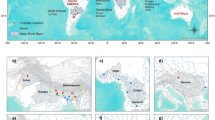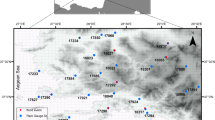Abstract
Very intense rainfall during the southwest and northeast monsoons causes severe river flooding in India. Some traditional techniques used for real-time forecasting of flooding involve the relationship between effective rainfall and direct surface runoff, which simplifies the complex interactions between rainfall and runoff processes. There are, however, serious problems in deducing these variables in real time, so it is highly desirable to have a real-time flood forecasting model that would directly relate the observed discharge hydrograph to the observed rainfall. The storage routing model described by Baba and Hoshi (1997), Tanaka et al. (1997), and Baba et al. (2000), and a simplified version of this model, have been used to compute observed river discharge directly from observed hourly rainfall. This method has been used to study rainfall–runoff data of the Ajay River Basin in eastern India. Five intense rainfall events of this basin were studied. Our results showed that the Nash–Sutcliffe efficiency of discharge prediction for these five events was 98.6%, 94.3%, 86.9%, 85.6%, and 67%. The hindcast for the first two events is regarded as completely satisfactory whereas for the next two events it is deemed reasonable and for the fifth it is unsatisfactory. It seems the models will yield accurate hindcast if the rainfall is uniform over the drainage basin. When the rainfall is not uniform the performance of the model is unsatisfactory. In future this problem can, in principle, be corrected by using a weighted amount if rainfall is based upon multiple rain-gauge observations over the drainage basin. This would provide some measure of the dispersion in the rainfall. The model also seems unable to simulate flooding events with multiple peaks.






Similar content being viewed by others
References
ASCE Task Committee on Definition of Criteria for Evaluation of Watershed Models of the Watershed Management Committee. Irrigation and Drainage Division (1993) Criteria for evaluation of watershed models. J Irrigation Drainage Eng ASCE 119(3):429–442
Baba H, Hoshi K (1997) An experimental study on synthetic storage routing model with loss mechanisms. Proc. 52nd annual conference, JSCE, vol 2, pp 316–317
Baba H, Hoshi K, Hashimoto N (2000) Synthetic storage routing model coupled with loss mechanisms. J Hydrosci Hydraulic Eng, JSCE 18(1):61–72
Nash JE, Sutcliffe JV (1970) River flow forecasting through conceptual models, part-1: a discussion of principle. J Hydrol 10:282–290
Prasad R (1967) A nonlinear hydrologic system response model. J Hydraulics Div, Proc ASCE 93(4):201–221
Tanaka A, Fujita M, Shimizu Y (1997) Study on storage function model with considering deep infiltration. Proc Hokkaido Chapter of JSCE 53(b)
Author information
Authors and Affiliations
Corresponding author
Rights and permissions
About this article
Cite this article
Perumal, M., Sahoo, B. Limitations of real-time models for forecasting river flooding from monsoon rainfall. Nat Hazards 42, 415–422 (2007). https://doi.org/10.1007/s11069-006-9082-1
Received:
Accepted:
Published:
Issue Date:
DOI: https://doi.org/10.1007/s11069-006-9082-1




